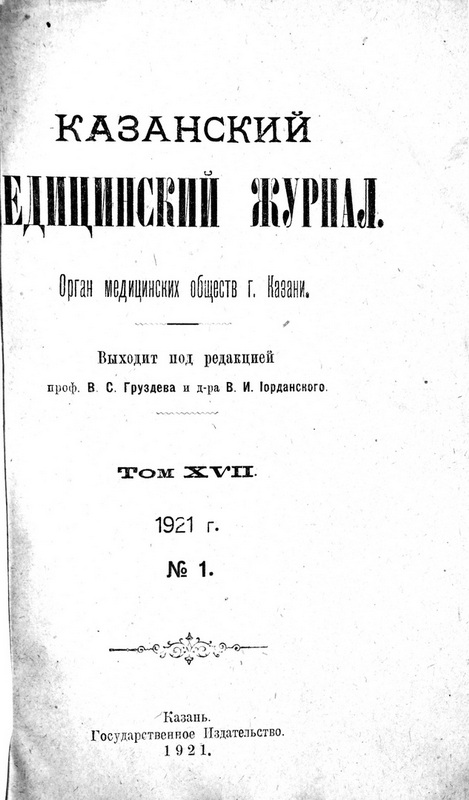Vol 17, No 1 (1921)
- Year: 1921
- Published: 14.03.1921
- Articles: 12
- URL: https://kazanmedjournal.ru/kazanmedj/issue/view/4112
Full Issue
The current state of the doctrine of the etiology of typhus
Abstract
In connection with the modern European war, and also in view of the well-known fact of the extraordinary development of typhus epidemics in wartime, both in the ranks of active armies and among prisoners of war, in recent years among doctors there has been a significant increase in interest in the etiology of typhus. This interest, in addition, was largely fueled by those reports in the special literature that were made by a number of authors, and in particular Nicoll and his students, who published the results of their work and observations during the typhus epidemic in Tunisia.
 5-31
5-31


Weil-Felix reaction in typhus
Abstract
Despite the fact that until now we do not know the true causative agent of typhus infection, in the literature there are a number of observations concerning immunity reactions in the serum of typhus patients, observations that, bringing us closer to solving the question of the causative agent of typhus, do not are only of theoretical interest, but even now they can be practically used at the patient's bedside.
 32-36
32-36


Vaccination experiments for typhus.
Abstract
The first attempts to protect a person from falling ill with typhus were made by Nicolle, as well as by the American researchers Gavino and Girard. These authors used the blood of typhus patients as an inoculum, based on the fact that an unknown causative agent of the disease is undoubtedly contained in the blood of an infected organism.
 37-41
37-41


 42-58
42-58


On the cultivation of the spirochete Obermeiera.
Abstract
Currently, we know several types of human blood spirochetes. The best studied are the following four species: 1) spirochete Obermeier'a, or spir. recurrentis, the causative agent of European relapsing fever, discovered Obe g me ie th in 1873, 2) spiroch. Duttoni, the causative agent of the African form of relapsing fever, discovered by Ros S'OM and Mi1Pe'om, as well as Dutton'OM and Todd'oM in 1904, 3) spiroch. Kochi, discovered in 1905
 59-67
59-67


 68-80
68-80


To the symptomatology of extensive gastric contractions
Abstract
When it comes to the narrowing of the stomach, we most often mean the narrowing of its openings, in the cardiac or pyloric part, and, although these narrowings are relatively small in length, they create very significant disturbances in the functional activity of the stomach; for the most part these are either neoplasms or scars from healed ulcers.
 81-90
81-90


On the issue of surgical intervention for gunshot wounds of the skull and its contents, according to observations in the war of 1914-1917
Abstract
Surgeons who worked in the last European war at the front on the question of the nature and timing of surgical intervention for gunshot wounds to the skull and its contents were divided into 3 camps: some were the principal supporters of the view of Bergmanna and his associates
 91-105
91-105


On the clinical significance of posterior inclinations and bends of the uterus (retroversio-flexio uteri)
Abstract
In the expiring academic year, I had to observe, in the Obstetric and Gynecological Clinic of the University that I was eating, the following case, which is of interest not only for gynecologists, but also for therapists, neuropathologists and surgeons
 106-129
106-129


Favorable orthopedic treatment outcomes for severe morbus Iiittle'i
Abstract
On 15 / Ѵ 1921, a patient, a 5-year-old boy, Anatoly Peterson, was admitted to the Orthopedic Institute with the phenomenon of extremely sharp spastic paraplegia of the lower extremities: the hips are bent, slightly rotated inward and extremely sharply brought, as a result of which the knees go crosswise one after the other (left in front of the right) and also bent; very significant plantar flexion of both feet (pes eqquinus).
 130-132
130-132


A few words about the arthrodesis operation
Abstract
The operation of arthrodesis, or artificial ankylosis of the joint, first performed by Albert in 1878, is one of the most beneficial orthopedic methods of treatment in cases of complete paralysis of all muscles moving this joint and in cases of ankylosis in a functionally disadvantageous position of the joint, when a quick recovery of the patient's ability to work is required if it is impossible, for one reason or another, to use his orthopedic devices.
 133-134
133-134


On the essential form of ineontinentiae urinae or incontinence neurosis in connection with the question of simulating this suffering
Abstract
In his report, made at the Scientific Meeting of Doctors of the Kazan Military Hospital, the speaker dwells on a special form of disorder of the act of urination, the so-called. neurosis of incontinence, operating on significant material from the nervous department of the said hospital.
 135-136
135-136











